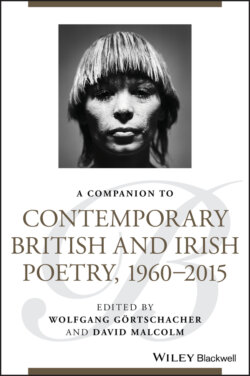Читать книгу A Companion to Contemporary British and Irish Poetry, 1960 - 2015 - Группа авторов - Страница 12
Introduction
ОглавлениеThe story is a well‐known one, and this volume presents it in individual essays. The Movement. Alvarez's The New Poetry. The Liverpool poets. The Northern Irish. The British Poetry Revival. The Martians. Linguistically innovative poetry. Black British poetry. Women's poetry. Gay and lesbian voices. The abiding forces of regional poetry. American models. The stars: Philip Larkin, Ted Hughes, Seamus Heaney, Geoffrey Hill, Tony Harrison, Paul Muldoon, and Carol Ann Duffy.
It occurred to us that we could retell that story here. But it had been told so often, and is told, we believe—with much else besides (thematic and genre‐ and technique‐centered essays, essays on writers within and without any obviously stellar grouping)—in the span of pieces contained in this volume. We felt we should do something different.
Our premises are twofold. First, the best and fullest engagement with poetry is an engagement, above all, with individual poems. Second—and this is, to a degree, a corollary of the first premise—this engagement involves an analysis and interpretation of what we would call technique, that is, the formal properties of a piece of verse. These properties include line length, stress placement, meter, and a panoply of phonological features (rhyme and other sound effects). These we conceive to be integral to the meaning of a poem, as much as—and in conjunction with—thematic reference and imbrication in the historical and social contexts. These premises have guided the organization of the introduction.
It consists of three parts. In the first, we suggest that a great deal of modern criticism of poetry does everything in its power to avoid speaking about technical aspects of any piece or body of verse. We are not sure why, except that it is probably easier to maunder on impressionistically about the topics of a piece of verse as Fiona Sampson does than to sit down and actually analyze a poem. We contend, however, that if you do not analyze and interpret technique, you are at best only doing half your job. Thus, the second part of this opening chapter contains brief analyses of 20 poems of substance from the period embraced by this collection. Restrictions of available space limit how much we can do in any analysis. We have adopted a minimum technique of analysis, which has the merit of being accessible. We hope readers can see the general principles underlying our approach. We contend that this set of analyses offers some interesting insights into how British and Irish poetries are configured in the second half of the twentieth century and at the beginning of the twenty‐first century. Our discussions perhaps allow a slightly different—and complementary—story to the traditional one. It certainly brings with it some unexpected juxtapositions. Thus, third, we offer some general remarks on British and Irish poetry in the period.
